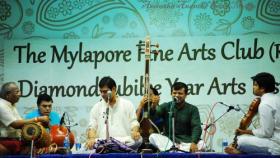
K.N. Sashikiran and P.Ganesh dubbed as Carnatic Brothers have an impressive repertoire in Carnatic music, which was evident in their selection to present in Mylapore Fine Arts concert on 13th December, 2011.
Duos in Carnatic Music is not a new phenomenon. Alathus Brothers, B.V.Raman – B.V.Lakshmanan, the Bombay Sisters, the Hyderabad Brothers, Malladi Brothers and so many more combinations have occupied the concert stage for many years now and quite successfully at that.
Just like Alathur Brothers, who were not really brothers (not even related), the Carnatic Brothers – K.N. Sashikiran and P.Ganesh – are also not real brothers, but cousins; they share the same musical lineage of Gottuvadyam Narayana Iyengar, both being grandsons of this legendry vidwan of a golden era.

The concert started with a brisk Navaragamalika varnam “Intha Kopa” of Veenai Kuppiar. It is very rare to hear this varnam in the concert circuits. The beauty of this varnam is that it has the ganaragas Nattai, Gaula, Varali, Aarabhi, Sri up to Mukthayi swaras and Narayanagowla, Reetigowla, Bowli, Kedaram in Chittaswaras. It is always nice when vidwans take time to learn many unsung varnams to bring them to fore instead grinding the same few varnams they learn during formative years. Kudos to both of them.
 Thyagararaja’s “Janaki Ramana” in Suddha Seemandhini followed quickly, with a beautiful package rendering of niraval in usual place “Rakthanalinadala”. Ganesh in particular had some exquisite phrases in the niraval and swaras.
Thyagararaja’s “Janaki Ramana” in Suddha Seemandhini followed quickly, with a beautiful package rendering of niraval in usual place “Rakthanalinadala”. Ganesh in particular had some exquisite phrases in the niraval and swaras.
Surutti has its simple majesty which was carved out by Ganesh in his delineation. It was equally embellished and reflected by Mysore Srikanth in his violin display. Dikshitar’s brilliant navagraha keerthanai, “Angaaragamashrayamyaham” is an apt selection for a Tuesday concert and the duo delivered with such purity despite the heavy strokes of Sri Mushnam Rajarao on mridangam.
Chithraveena Ravikiran has quite a few compositions to his credit and his Rasikapriya krithi “Rasikapriya raga rasikapriya” had the essence of this ragam in ample measure captured through words and tuning.

The main and major part of the concert was devoted to RTP in ragam Varamu, otherwise (originally) known as “Shudda Hindolam”. Shashikiran had a deliberated slow approach where he enjoyed singing the ragam – which is in fact very important in order to take the audience to the same plane of bliss and enjoyment.
The tanam followed and was shared by the duo and violin accompaniment, with Begada by Ganesh, Kapi by Srikanth and Mukari by Ganesh again. Ganesh ended the thanam in reverse order of all the ragams touched during thanam with an impressive display of his control and mastery over the art. The pallavi lines “Varuvai mayilai karpagame varamunadhe arulave” in Adi talam, double count, with ½ eduppu (beginning) were sung with usual mathematical permutations and laya mastery.

Another creative aspect of swara singing included weaving of ragas that has the word “Shuddha” embedded in the name. The garland included ragams like Karnataka Shuddha saveri, Shuddha Dhanyasi, Shudda Bangala. Once again Ganesh had a spectacular display and wet on an imaginative spree, seamlessly transitioning from each ragam in reverse order culminating in Korvai math in Varamu.
One noticeable aspect was that the high pitched voice of Ganesh and the solid voice in lower octave of Shashikiran had a very nice harmonizing effect together in many places and showed their maturity in understanding each other strength and leveraging it fully.
A javali “Samayamidhe” in Behag, Gangadeeshwaram in Sindhu Bhairavi (popularized by late Shri. D.K. Jayaraman) and a Thirppugazh (Sankeerna chapu) in Valaji ended the concert to every discerning rasika’s utmost satisfaction.
Mysore Srikanth was an excellent support both in quality and measured playing, not a bad stroke during the entire performance.
Speaking of bad strokes, Shri. E.M Subramaniam’s Ghatam playing was totally masked, muted and sidelined by thunderous overdo of Mridangam master Srimushnam Rajarao.
When the percussion artist has his own share of time to play alone, many in the audience were left wondering why he needed to steal time from the main artists to justify his play during “thanam” singing. His strokes were slightly indifferent and rather interfering to say the least. Rasikas need not be given a pep talk as to what to enjoy or not.
PHOTO CREDITS: AMRUTHA ANANTH








